Rembrandt van Rijn is one of the greatest painters in history. His artwork is well-known for its remarkable artistry, attention to detail, and realism. His works have captured the hearts of art lovers for centuries and continue to inspire new generations of artists. In this article, we’ll delve into the top ten most famous Rembrandt paintings, offering a brief yet insightful analysis of the themes, techniques, and historical context behind each masterpiece.
Spanning from his early works to his later developments, each painting tells a unique story, showcasing Rembrandt’s immense talent and exceptional artistic vision. Whether you’re an experienced art connoisseur or merely curious about the genius of Rembrandt, you’ll undoubtedly discover something to appreciate in this compilation of his celebrated masterpieces.
The Anatomy Lesson of Dr. Nicolaes Tulp
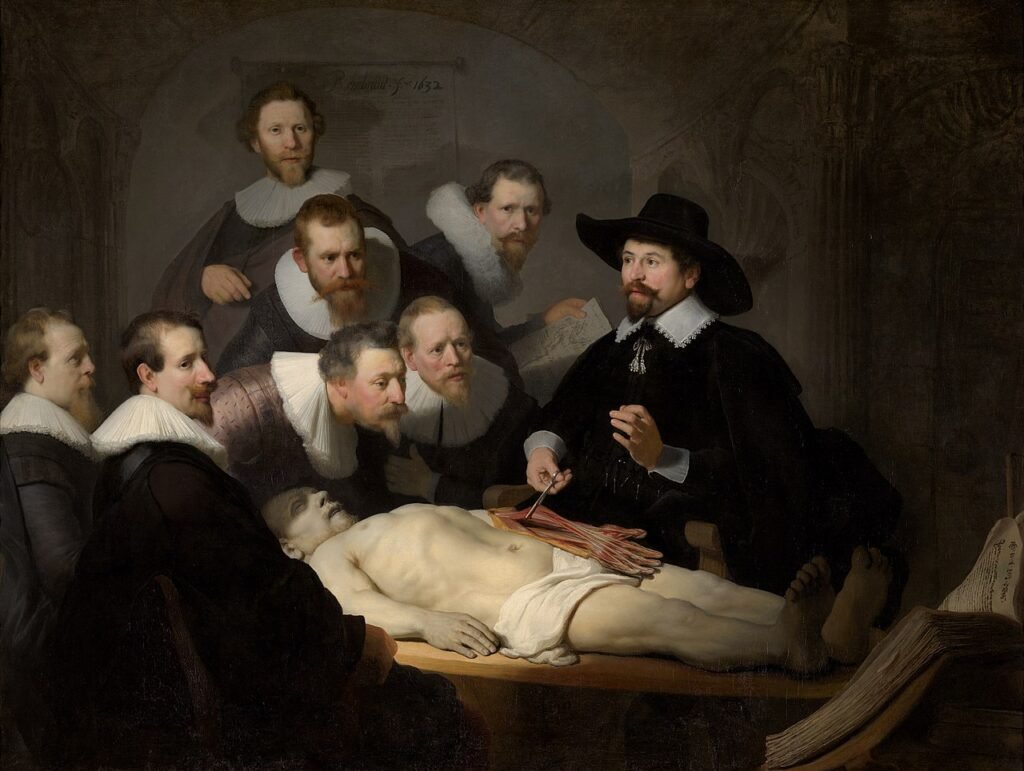
Year: 1632
The painting named “The Anatomy Lesson of Dr. Nicolaes Tulp” portrays Dr. Nicolaes Tulp, a prominent Dutch surgeon who later became the mayor of Amsterdam, conducting an anatomy lesson on the body of Aris Kindt, a criminal executed in 17th century Holland.
Public autopsies on executed criminals were held once a year during that time. The Amsterdam Guild of Surgeons commissioned the painting for their board room and it is currently exhibited in the Mauritshuis art museum located in The Hague.
The Return of the Prodigal Son
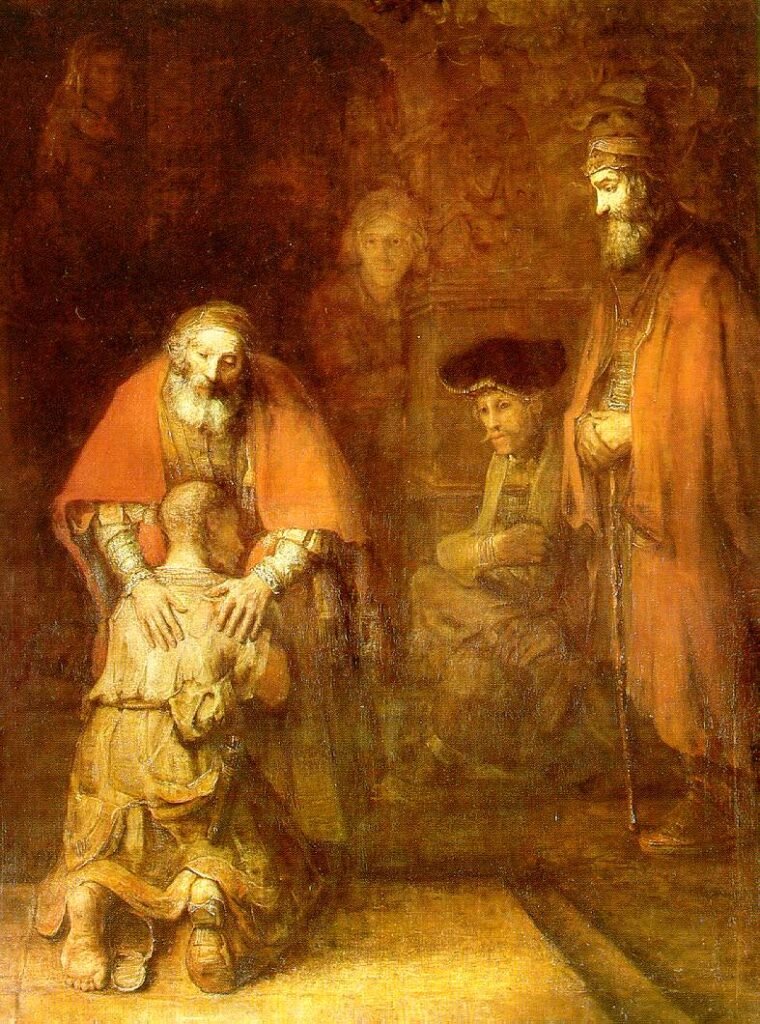
Year: 1669
The painting known as “The Return of the Prodigal Son” is believed to be one of the final pieces of the renowned Dutch painter’s career, completed just before his passing.
The life-sized artwork depicts the Biblical narrative in which the prodigal son returns to his father, expressing remorse for his wrongdoing and seeking forgiveness. Despite uncertainty about the identities of the other individuals depicted in the painting, specifically the unforgiving elder brother, it remains a significant piece in the Hermitage Museum’s collection of Western European Art.
Some experts suggest that the figure could be the young man at the doorway in the back, while others believe that it is the standing man located on the right-hand side.
The Storm on the Sea of Galilee
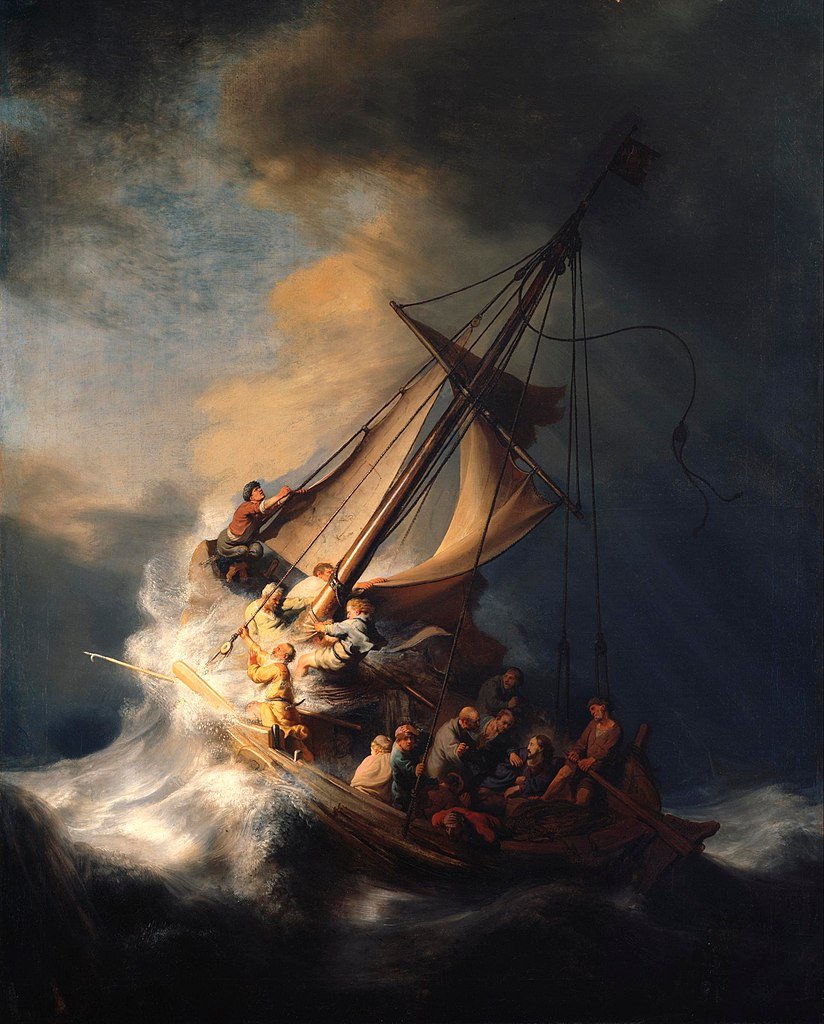
Year: 1633
The artwork known as The Storm on the Sea of Galilee, which depicts the miracle of Jesus calming the storm, is unfortunately lost for over two decades. This Rembrandt painting was the only one set in a seascape setting.
In 1990, it was stolen from the Isabella Stewart Gardner Museum in Boston by two thieves disguised as police officers, along with 11 other major artworks, including Rembrandt’s Portrait of a Lady and Gentleman in Black, worth a total of $300 million.
Despite the FBI announcing in 2013 that they know who committed this one of the largest art heists in history, the frames that once held the masterpieces remain empty.
The Night Watch

Year: 1642
The Night Watch, a group portrait of the militia company led by Captain Frans Banning Cocq and Lieutenant Willem van Ruytenburgh, is arguably the most renowned painting created by Rembrandt.
Originally believed to depict a night scene, the mid-1940s cleaning process revealed that it actually took place during daylight hours. During an 18th-century relocation, the painting underwent significant trimming, with the left side losing some characters.
This alteration, however, had the unintended consequence of making the lightly clothed girl and Lieutenant the main focal point of the composition. Today, The Night Watch is on display at Rijksmuseum in Amsterdam.
The Conspiracy of Claudius Civilis
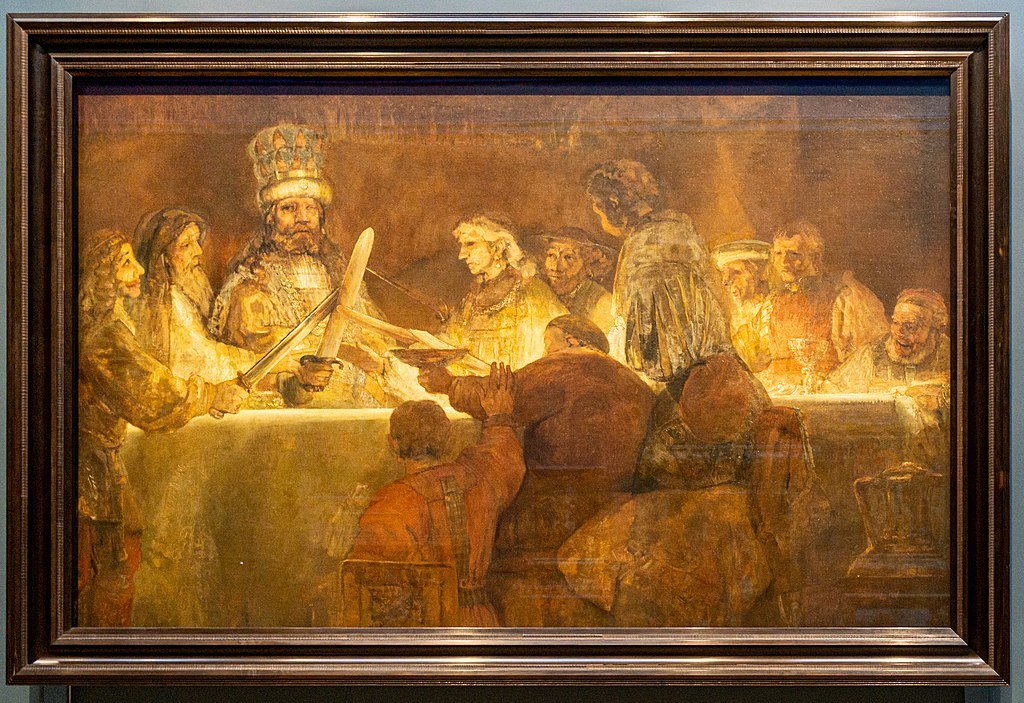
Year: 1661-62
Rembrandt’s final painting which had a worldly subject matter depicts Claudius Civilis, the leader of the Batavian Rebellion, and the Batavi chiefs promising to unite and oppose the Roman Empire.
The Conspiracy of Claudius Civilis was created for the new Town Hall in Amsterdam as a commissioned piece but was later returned to Rembrandt and significantly reduced in size (to one-quarter of the original) and slightly modified so it could be sold more easily.
The Royal Swedish Academy of Arts acquired the painting in the 18th century, and it was subsequently deposited in the National Museum in Stockholm, where it still resides today.
Self-Portrait with Two Circles
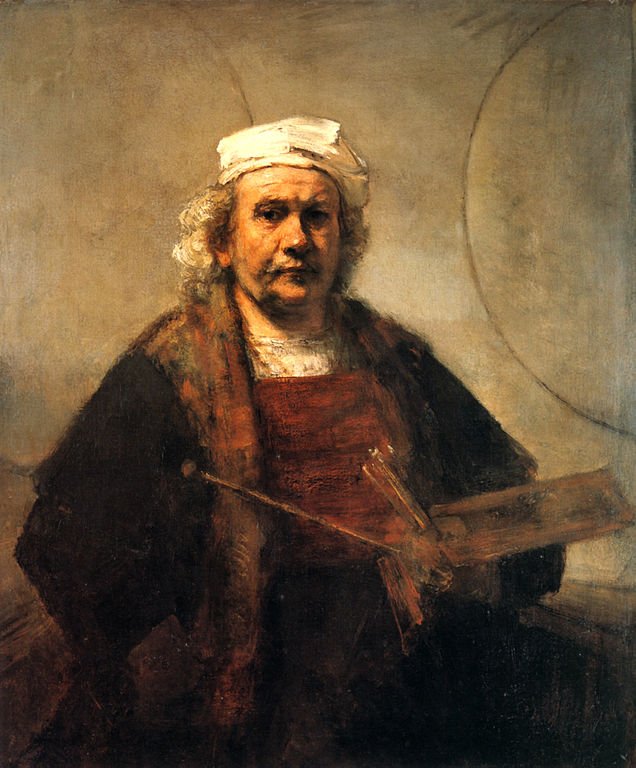
Year: 1665-69
The Self-Portrait with Two Circles, created between 1665 and 1659, is considered one of Rembrandt’s finest self-portraits and a masterpiece of his later years.
The self-portrait depicts the artist at work, holding his palette, brushes, and maulstick with two mysterious circles in the background.
Despite several theories about the circles’ meaning, ranging from a map of the world to various symbolic interpretations, the reason for their inclusion and what Rembrandt was attempting to convey remains a mystery. The painting is currently exhibited at Kenwood House in London.
Bathsheba at Her Bath
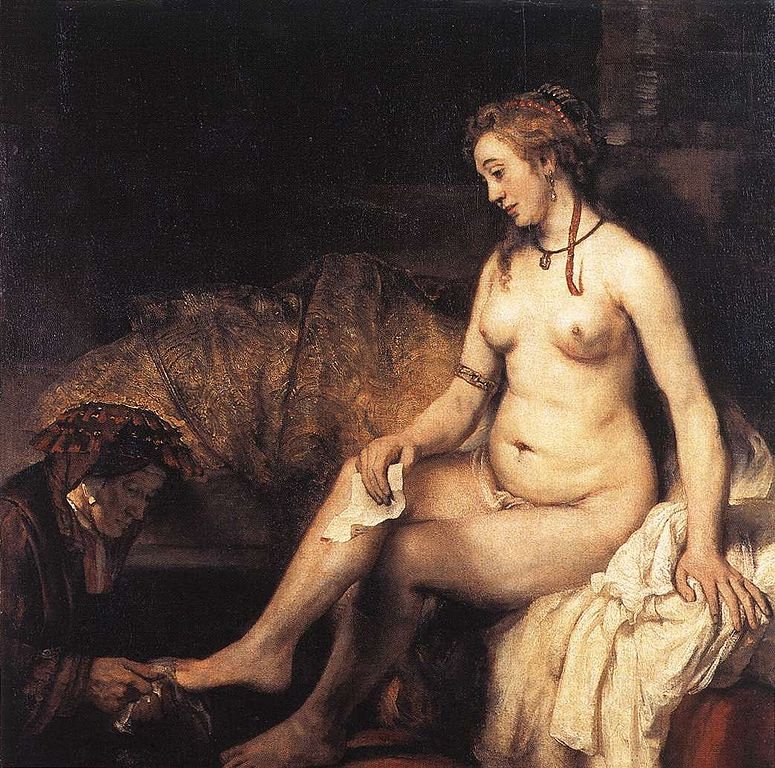
Year: 1654
The painting “The Bathsheba at Her Bath” was completed in 1654 and depicts Bathsheba, the wife of Uriah the Hittite, who was spotted by King David from the roof of his palace.
As per the biblical account, David had her brought to him for sexual relations which led to her pregnancy. In an attempt to manipulate the situation, David called Uriah back from the army, hoping he would have sex with Bathsheba and assume he fathered the child.
Unfortunately, Uriah did not consummate the marriage, and as a result, the King ordered his general to place Uriah on the front lines to guarantee his death. Subsequently, after Uriah’s death, David married Bathsheba, who was now a widow. The artwork is presently exhibited in the Louvre Museum in Paris.
Belshazzar’s Feast

Year: 1635-38
Rembrandt portrays a story from the Old Testament (Daniel 5: 1–5, 25–8) in his dramatic painting. The main figure wearing a gold cloak, an enormous turban, and a tiny crown is Belshazzar, the King of Babylon. Belshazzar’s father had stolen all the sacred vessels from the Temple of Jerusalem, and using them to serve food at a feast was considered sacrilegious.
During the feast, there was a sudden clap of thunder that acted as a warning. A hand appeared from a cloud and wrote in Hebrew words “You have been weighed in the balance and found wanting.” Within hours, Belshazzar died.
Although people in Amsterdam had plain churches, they had religious pictures in their homes, some of which depicted this story. They were encouraged to read the Bible and would have known about Belshazzar’s fate and the cautionary moral of the story of a wicked king who was watched by heavenly eyes, much like the recorder player watching from the shadows with piercing eyes.
Old Man with a Gold Chain
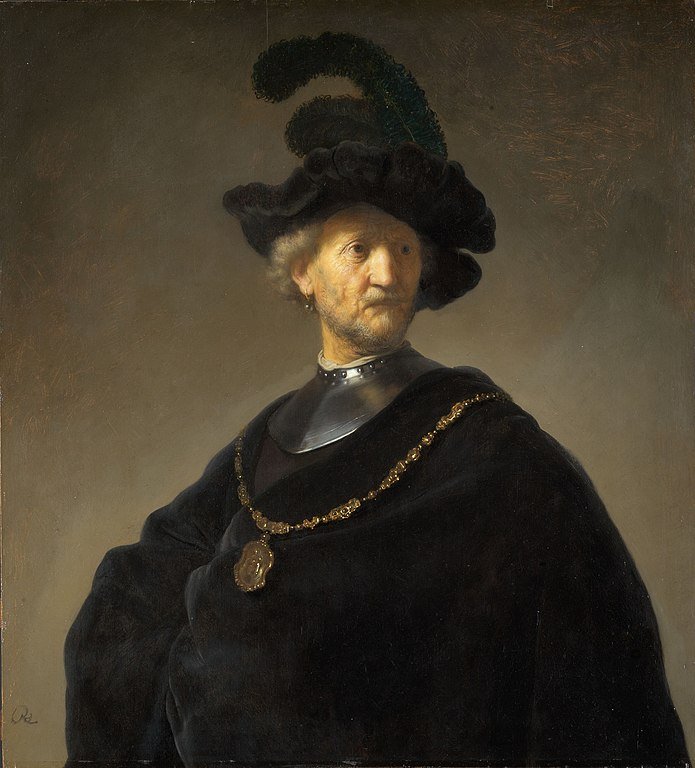
Year: 1631
The artist explored the impact of a solitary figure, by employing striking costumes and subtle lighting. Rembrandt used different attire to transform his models into various characters.
In this particular portrait, the military career of the sitter is indicated by the gold chain and steel gorget, while the plumed beret reflects an earlier period. The darkened silhouette of the man’s torso against a neutral backdrop contrasts remarkably with these adornments. The sitter’s face displays a realistic and weathered appearance, radiating with pride and humanity.
Although the identity of the subject remains unidentified to date, he was one of the artist’s early and favored models, who often appeared in Rembrandt’s earlier creations. Completed around 1631, shortly after his move from Leiden to Amsterdam, the artist’s confident execution highlights his skills in merging historical art with portraiture, as evidenced by this painting.
Danaë
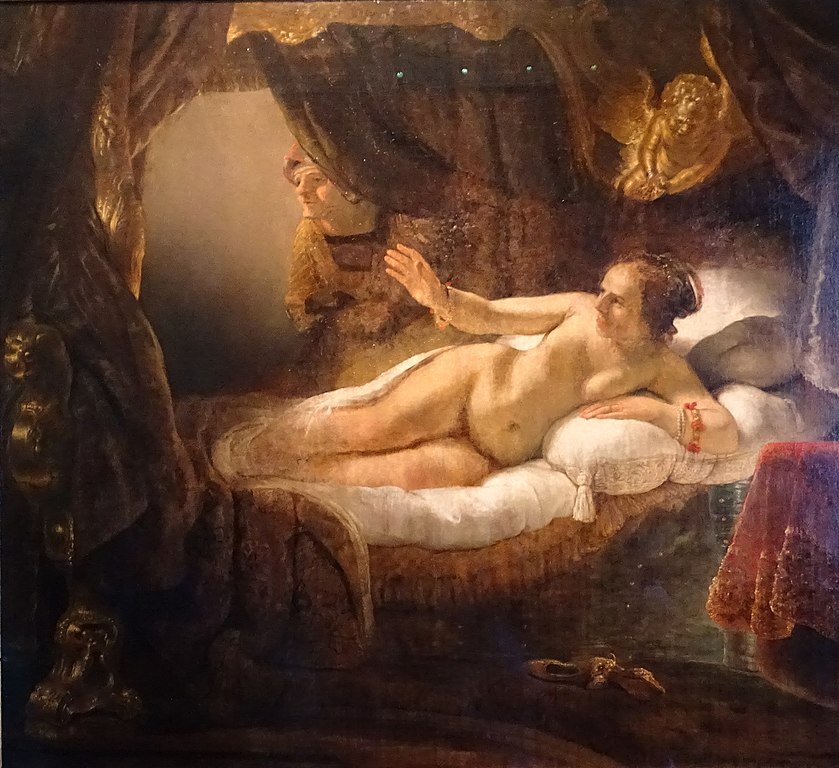
Year: 1636
Danaë by Rembrandt, completed in 1636, is not only one of the finest nude paintings but also one of the remarkable masterpieces by the celebrated Dutch artist.
The painting portrays Danaë, the mother of the ancient Greek hero Perseus, as indicated by its title. It is believed that the life-size depiction of Danaë depicts her welcoming Zeus, who appeared to her as golden rain. Catherine II of Russia acquired the painting in the 1770s, and it has been kept at the Hermitage Museum in Saint Petersburg ever since.
